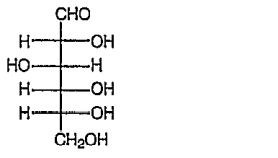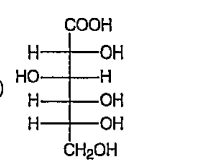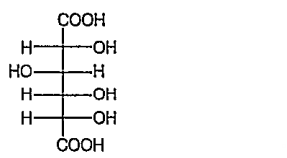Write the reactions involved when D-glucose is treated with the following reagents:
(i) Br2 water
(ii) H2N−OH
(iii) (CH3CO)2O
To solve the problem of how D-glucose reacts with the given reagents, we will go through each reagent step by step.
Step 1: Reaction of D-Glucose with Bromine Water (Br₂ in water)
1. Oxidation of Aldehyde Group: D-glucose contains an aldehyde group (-CHO) at one end of its structure. When treated with bromine water, which is a mild oxidizing agent, the aldehyde group is oxidized to a carboxylic acid group (-COOH).
The reaction can be represented as:
D-glucoseBr2/H2O−−−−−→Gluconic acid
Structure of Gluconic Acid:
HOOC-CHOH-CHOH-CHOH-CHOH-CH2OH
Step 2: Reaction of D-Glucose with Hydroxylamine (H₂N-OH)
1. Formation of Oxime: Hydroxylamine reacts specifically with the aldehyde group of D-glucose. The nucleophilic nitrogen of hydroxylamine attacks the carbonyl carbon of the aldehyde, leading to the formation of an oxime.
The reaction can be summarized as:
D-glucose+H2N-OH→Glucose oxime
Structure of Glucose Oxime:
HOCH2(CHOH)3C=N-OH
Step 3: Reaction of D-Glucose with Acetic Anhydride (CH3CO)2O
1. Formation of Acetate Derivatives: When D-glucose is treated with acetic anhydride, all hydroxyl (-OH) groups on the glucose molecule are converted into acetate groups (-OCOCH₃). This reaction is known as acetylation.
The reaction can be represented as:
D-glucose+(CH3CO)2O→Glucose pentaacetate
Structure of Glucose Pentaacetate:
OCOCH3(OCOCH3)(OCOCH3)(OCOCH3)(OCOCH3)
Summary of Reactions:
1. With Bromine Water: D-glucose is oxidized to gluconic acid.
2. With Hydroxylamine: D-glucose forms glucose oxime.
3. With Acetic Anhydride: D-glucose is converted to glucose pentaacetate.
The reaction can be represented as:
D-glucoseBr2/H2O−−−−−→Gluconic acid
HOOC-CHOH-CHOH-CHOH-CHOH-CH2OH
D-glucose+H2N-OH→Glucose oxime
HOCH2(CHOH)3C=N-OH
D-glucose+(CH3CO)2O→Glucose pentaacetate
OCOCH3(OCOCH3)(OCOCH3)(OCOCH3)(OCOCH3)
1. With Bromine Water: D-glucose is oxidized to gluconic acid.
2. With Hydroxylamine: D-glucose forms glucose oxime.
3. With Acetic Anhydride: D-glucose is converted to glucose pentaacetate.
Topper's Solved these Questions
- BIOMOLECULESBOOK - MODERN PUBLICATIONCHAPTER - BIOMOLECULESEXERCISE - Revision Exercises (Objective Questions)(LongAnswer Questions)
3 Videos
- BIOMOLECULESBOOK - MODERN PUBLICATIONCHAPTER - BIOMOLECULESEXERCISE - HIGHER ORDER THINKING SKILLS (ADVANCED LEVEL QUESTIONS WITH ANSWERS)
14 Videos
- BIOMOLECULESBOOK - MODERN PUBLICATIONCHAPTER - BIOMOLECULESEXERCISE - Revision Exercises (Objective Questions)(Very Short Answer Questions)
33 Videos
- ALDEHYDES ,KETONES AND CARBOXYLIC ACIDSBOOK - MODERN PUBLICATIONCHAPTER - ALDEHYDES ,KETONES AND CARBOXYLIC ACIDSEXERCISE - UNIT PRACTICE TEST
13 Videos
- CHEMISTRY IN EVERYDAY LIFE BOOK - MODERN PUBLICATIONCHAPTER - CHEMISTRY IN EVERYDAY LIFE EXERCISE - UNIT PRACTICE TEST
13 Videos
Similar Questions
Knowledge Check
What is the product formed when D-glucose is treated with Br2 water?
A B
B C
C D
D
(a) Write the structures of main products formed when aniline reacts with the following reagents:
(i) Br2 water
(ii) HCI
(iii) (CH3CO)2 O/pyridine
(b) Arrange the following in the increasing order of their boiling point:
C2H5NH2,C2H5OH,(CH3)3N
(c) Give a simple chemical test to distinguish between the following pair of compounds:
(CH3)2NH and (CH3)3N
View SolutionWhat happens when D-glucose is treated with the following reagents ?
(i) HI (ii) Bromine water (iii) HNO3
View Solution(a) Write the structures of main products when aniline reacts with the following reagents :
(i) Br2 water
(ii) HCl
(iii) (CH3CO)2O/pyridine
(b) Arrange the following in the increasing order of their boiling points :
C2H5NH2,C2H5OH,(CH3)3N
(c) Give a simple chemical test to distinguish between the following pair of compounds :
(CH3)2NH and (CH3)3N
View SolutionWrite the chemical equations involved when C2H5NH2 is treated with the following reagents :
(i) CH3COCl/pyridine
(ii) C6H5SO2Cl
(iii) CHCl3+KOH
View SolutionWrite the equations for the reaction of phenol with the following:
(i) Br2 water
(ii) CHCl3+NaOH
(iii) Na2Cr2O7+Conc.H2SO4.
View SolutionCalculate the molecular mass of the following :
(i) H2O
(ii) CO2
(iii) CH4
View SolutionCalculate the molecular mass of the following :
(i) H2O
(ii) CO2
(iii) CH4
View Solution
